3 min read
ZeroSum Market First Report February 2023: Used Vehicle Inventory Faces Sharpest Decline in Almost Two Years
ZeroSum
Feb 23, 2023 11:00:11 AM
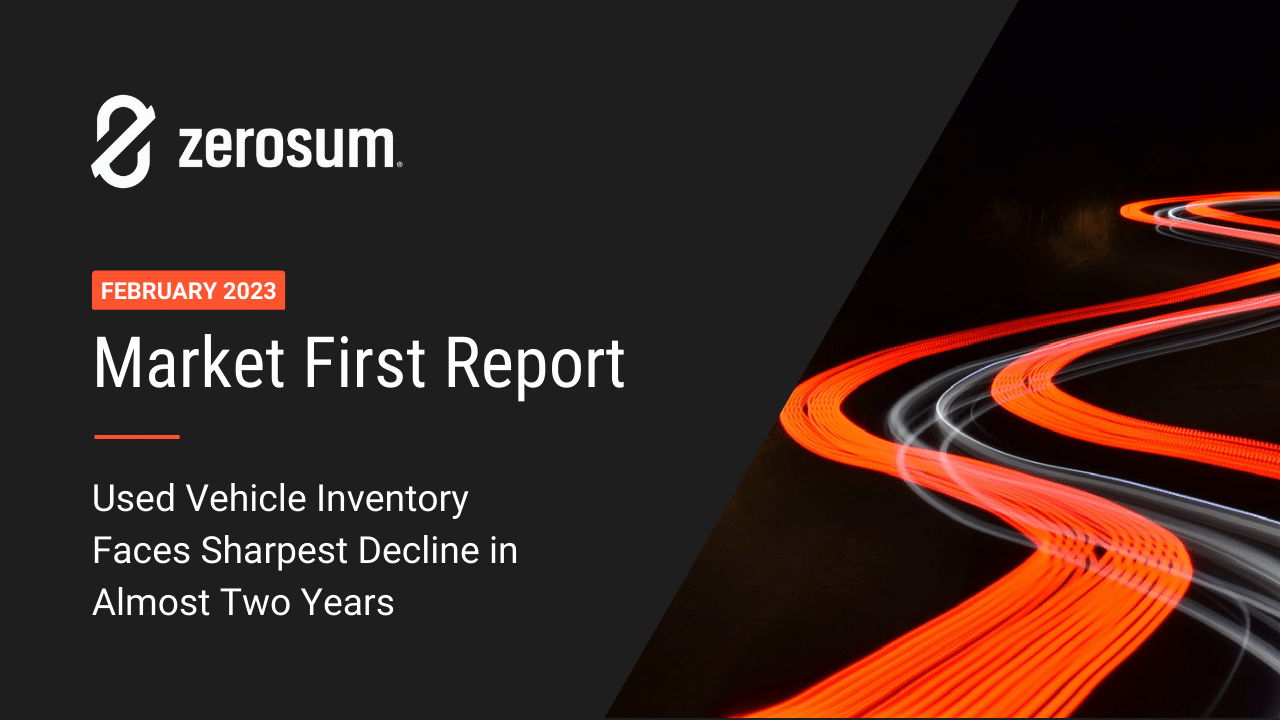
The ZeroSum Market First Report is the automotive industry’s first source to predict month-end vehicle movement, providing vital supply and demand trend data to automotive marketers and dealers. ZeroSum uses predictive modeling to accurately estimate new vehicle inventory, pricing trends, and market share.
Quick-Access:
1. Summary: What You Need to Know
2. New Vehicles Retail Outlook
3. Used Vehicles Retail Outlook
4. Electric Vehicles Retail Outlook
Available Inventory Shifts From Used to New
We have seen some huge shifts in the automotive industry this month, especially in terms of inventory. Used vehicle inventory saw a massive decline in February, losing 7.55% while new inventory increased another 0.81%. At the same time, new vehicle prices continue to increase while used cars lose value.
In the EV market, inventory rose almost another 8% this month. With supply chains recovering and manufacturers ramping up production, the United States is now the second-largest EV market, just edging out Germany. During the Super Bowl, several auto makers including Ram, Jeep, and Kia got into the advertising game.
ZeroSum’s Take: What You Need to Know
Right now, new vehicle inventory is up, and used vehicle inventory is down. As these trends continue, dealers will need to rely more heavily on new vehicle sales to turn profits.
Here are your key takeaways:
- Utilize increased new vehicle inventory. Increase profits by acquiring and selling more new cars as prices rise.
- Maintain a high turn rate. As prices decline, avoid losing value on used cars by moving them off your lot quickly.
- Keep an eye on demand. As new car prices increase, some consumers will switch from the new car market to the used car market.
New Vehicles Retail Outlook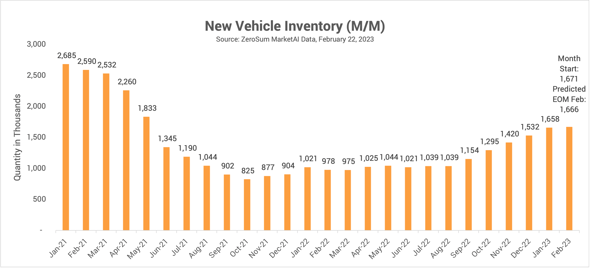
At the start of the month, inventory was up 0.81%. By the end of February, ZeroSum expects new vehicle inventory to sit at 1,665,779 vehicles. This is the sixth month in a row that there have been more new cars on the ground, further demonstrating supply chain recovery. With so many new cars becoming available, dealers should maintain a high turn rate to ensure maximum allocation from manufacturers.
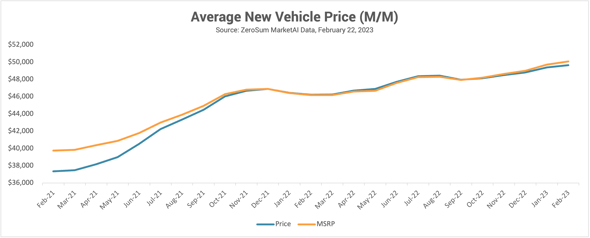
This month, the average price of a new car is up 0.54% to $49,655. Although new vehicle prices have risen over the last five months, the gap between price and MSRP has widened. Right now, average price is $438 below MSRP while in October 2022 it was only $54 below MSRP. This means that as MSRP rises, new vehicle prices do not increase as fast. With prices getting higher, some shoppers will be priced out of the new car market. Dealers should keep an eye out for increased demand for used cars as new cars become more expensive.
Used Vehicles Retail Outlook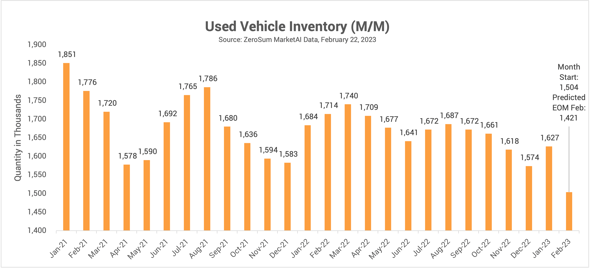
In February, used vehicle inventory saw the biggest change since April 2021, dropping 7.55% to just over 1.5 million vehicles. This is a significant drop, especially when compared to the 3.41% increase in inventory in January. ZeroSum predicts that by the end of the month, this number will decrease even more to 1,421,241 cars available. To make up for decreased used vehicle inventory, dealers should focus more on acquiring and marketing new vehicles that are most in demand.
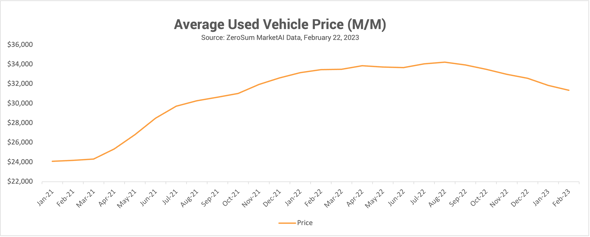
Inventory is not the only number decreasing in the used car market. For the sixth consecutive month, used vehicle prices dropped, losing another 1.56% in February. Now, the average price of a used car sits at $31,365. While used car prices are declining, dealers should focus on turning cars faster to avoid sacrificing profit.
Electric Vehicles Retail Outlook
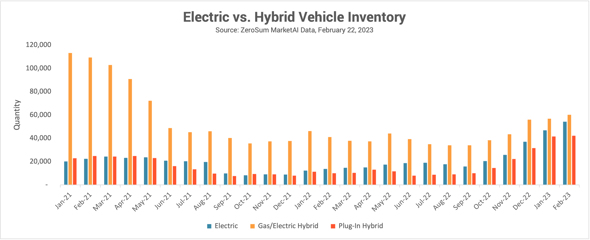
This month, Tesla announced it would open part of its charging network to other vehicles, a move that will make it a lot easier for drivers to find charging stations. Speaking on this issue, President Joe Biden tweeted “In building our EV charging network, we have to ensure that as many chargers work for as many drivers as possible.” With 49% of shoppers afraid they won’t be able to find a charging station, the promise of more widely available chargers will remove some barriers that prevent people from pulling the trigger on an EV.
The demand for electric vehicles is high and so is supply. Electric vehicle inventory increased for the fifth straight month in February, gaining 7.87% overall. Purely electric vehicle inventory added the most, up 15.63%, followed by gas/electric hybrid vehicle inventory which gained 6.05% and plug-in hybrid inventory which gained 1.62%.
About ZeroSum Market First Report
ZeroSum’s Market First Report is based on ZeroSum’s retail vehicle movement and pricing indices, powered by real-time data gathered using ZeroSum’s data-driven marketing platform MarketAI. The platform brings together vast amount of data, including all available light vehicle inventory in the U.S., to help improve marketing performance. MarketAI allows dealers to analyze their market in real-time, using sales conversion rates, market turn rates, days’ supply, and competitive inventory.
About ZeroSum
ZeroSum is a leader in software, marketing, and data. Powered by its SaaS platform, MarketAI, ZeroSum is simplifying and modernizing automotive marketing by leveraging artificial intelligence, data, and scaling ability to acquire new customers. ZeroSum is the first and only company that matches consumer demand with automotive data in real time. For more information, visit https://www.zerosum.ai/.
For media inquiries, please contact mdevilling@zerosum.ai.
Download a free copy of the ZeroSum Market First Report and receive the most recent automotive trends monthly!
